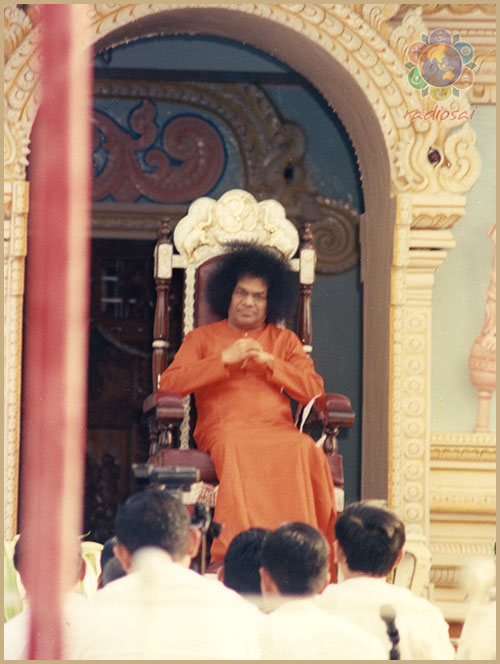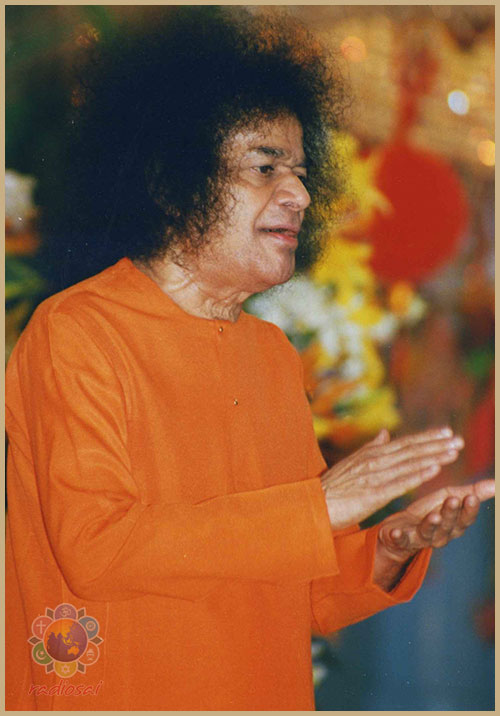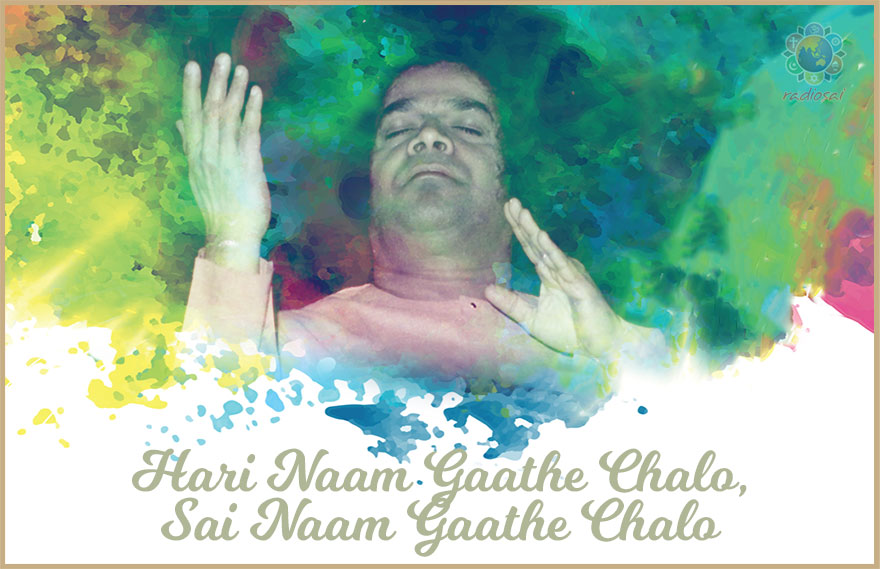| 'Like' us on Facebook | Follow us: |
Posted on: Nov 09, 2017
Hari Naam Gaathe Chalo
Let's Sing with Energy and Let His Energy Make Us Sing
In 1944, a group of families in Bengaluru who were all closely related to one another decided to congregate in one home every Thursday to do bhajans. So the bhajan session moved from one house to the other every week within that closed circle.
After they had successfully done this for a year without any break, they wanted to celebrate their 54-week sadhana by doing a non-stop 24-hour bhajan. So they sent a message to Bhagawan seeking His blessings. He was so delighted to receive their prayer that He said, “I will Myself come and personally bless you all!”
The devotees in Bengaluru were happy but also a bit anxious too. Coming from a lower middle-class background, they were worried because they did not have the resources to make proper arrangements for Bhagawan's arrival and stay. Besides, the World War II was on and it was extremely difficult to get any help from anyone. But He assured them saying, “I am coming not to your homes, but to your hearts.”
That is what bhajans do to the Lord. Wherever His name is sung with sincerity and devotion, He simply gets drawn to that place and installs Himself there. Bhagawan in fact sat through the entire 24 hours of the first akhanda bhajan in Bengaluru in 1945!
This tiny stream of akhanda bhajan with time acquired gigantic proportion as the Global Akhanda Bhajan wherein devotees in all lands and cultures, speaking varied tongues and from diverse races, in unison chant the name of the Lord non-stop for an entire day and night. Now it is one of the most-looked-forward-to events in hundreds of Sai centres and homes all over the globe.
As we prepare for this ‘bhajan binge’ on November 11 and 12, 2017, here is a small article which could help us make the most of this lovely opportunity.
This is the transcript of a conversation between Mr. Bala Ramchandran, an alumnus of Bhagawan's university who is also a gifted singer, and Radio Sai's Bishu Prusty. In this they ruminate on the inner significance of the bhajan “Hari Naam Gaathe Chalo”. This was part of the audio programme “Radio Sai Bhajan Classroom.”
Listen to Radio Sai Bhajan Classroom:
Hari Naam Gaathe Chalo
Bala Ramachandran (BRC): The most beautiful thing about Hari Naam Gaathe Chalo is that it talks about the journey. In fact the word ‘chalo’ occurs many times.
Bishu Prusty (BP): It means ‘move forward’.
BRC: I have noticed two patterns in this bhajan. One is that it refers to a journey. The second is, it tells us what will give us the energy for this journey and consistently sticks to one theme which is ‘The name of the Lord’ - “Hari Naam Gaathe Chalo, Sai Naam Gaathe Chalo”.
So the consistent idea of the bhajan is that of travel and the name of the Lord being the tonic which will give us the power to move forward.
When I was thinking about this bhajan, two things came to my mind. One is a quote by Francis Thompson in a famous poem which is also quoted in ‘Loving God’ by Prof. Kasturi who writes:
“Everyone whom He calls is provided with a thirst to come again. In fact, all roads lead to Prasanthi Nilayam, that is to say, His presence. When you have reached the journey's end, you will find Him, stretching arms to receive you saying, ‘Ah! Fondest, blindest, weakest: I am He whom Thou seekest.’”
 |
Prof. Kasturi also makes a very beautiful reference to another famous song which I am sure you would have heard. It goes like this - “Lead kindly light amidst the encircling gloom, lead thou me on.”
He ruminates on this idea and says, “You already have a light which is ready to lead you. Just the light is enough. So where is the need for you to be led by hand?”
But then he writes Swami's own answer to it. The Lord says that the light is not enough because we are not just meek and weak but also blind. So we need to be led literally by the hand. The Lord is so compassionate that He leads us by the hand.
In this particular bhajan, among the various names which have been used are ‘Madhava’, ‘Govinda’ and ‘Gopala’. Swami has told us many times that ‘go’ in spiritual parlance is the jivatma (individual soul) and ‘Govinda’ or ‘Gopala’ is the person who has the responsibility of leading the cows or these individual souls.
If we talk about Jesus, He is the shepherd. If we think about Krishna, He too is the person who leads the cows.
I remembered one more thing while talking about journeys. One day Ramakrishna Paramahamsa, while speaking to his disciples, said, “Rama needed a needed a bridge to cross the ocean. But His disciple, the monkey Hanuman, did not need the bridge to cross because he had the name of Rama.”
It is the name which gives the impetus to go forward on this journey. We are all cows or the jivatmas who are being led. The Lord leads us by the name.
BP: The name gives us all the power to move forward.
 |
BRC: Absolutely. In fact the first name used is ‘Hari’. Again quoting from the Gospel of Ramakrishna, one of his direct disciples once asked him, “How do we overcome the six vices which are our greatest enemies in the spiritual path? The biggest of them is the desire for sensual pleasure. How do we get over it?”
At that point of time in Dakshineshwar there was a Hatha Yogi. Hatha Yoga is a path by which we can overcome such tendencies. But Ramakrishna sternly warned the disciple against going there.
He said, “Do not go there because if you are not properly guided by a perfected soul, you could actually get attached to the body and instead of becoming a means it will become an end in itself.”
The disciple asked, “What is the way out? How do I overcome my craving for sensual pleasure?”
Very simply Sri Ramakrishna said, “Just chant the name of Hari.”
The disciple dismissed it thinking, “The master does not know a better way out. So he is just saying this.”
But then he felt he should try it and so chanted the name of ‘Hari’. Within a few months he started seeing results.
This is the story of a direct disciple called Yogananda whom Ramakrishna himself referred as a perfect soul or ‘Ishwara Koti’. So the name ‘Hari’ is very significant.
I also remember how once in Trayee Brindavan Swami described the power of the name through a nice example.
He said, “Let's say I want to call a particular person and I describe him saying, ‘Call the boy who is of medium height, wearing white shirt, square spectacles, and with a round face.' Then half of dozen boys may turn up. On the other hand if I say ‘Call Vinod’ then only one will come. That is the power of the name of the Lord.”
BP: In fact, the Avatar always emphasised chanting the name and singing bhajans. Right at the start of His mission Bhagawan gave so much impetus to bhajan singing that today you have the Sundaram bhajan group which has such a long history.
Even before the Prasanthi Mandir bhajan group started releasing any products, Bhagawan guided the devotees in Chennai to come out with cassettes and be an instrument in the propagation of the chanting of the name of the Lord. It has happened in so many other places too. He encouraged many to get into singing. It is such an easy medium.
In fact the other day I was reading the prophecies of one of the sages of yore who had written about what Kali Yuga will be like. The sage mentions all the evil designs that Kali Yuga would experience which we are now seeing - the conflict between brothers, corruption, lack of respect for women, etc.
There are 15 points on what this age will be like and everything matches - people's mental state, society's state, the character of leaders, and so on. But in the end he says that the only positive thing about Kali Yuga is this - it is easiest to attain the Lord in this age. Unlike any other era, you can only chant the name and attain the Highest.
BRC: Absolutely! Ironically it becomes easier. You do not need to do penance or sacrifices or pooja. Just the name is enough.
BP: See how Swami did it! He made chanting the name of the Lord so effortless and so enjoyable for us. It is not like doing penance where we have to undergo so much of physical and mental strain. It is not as if we have to do a lot of yagnas and we need resources or paraphernalia. He emphasised on bhajans which anyone can sing and He added a lot of music and beauty to it. Many people now spend their lifetime just singing bhajans.
BRC: So true. As you said, there is no requirement in terms of paraphernalia or prerequisites or qualifications of time and place. We could be doing anything and we can still chant the name of the Lord. In fact just saying ‘Om Sri Sai Ram’ about a thousand times takes approximately 8 to 10 minutes.
 |
That reminds me of a very interesting concept called ‘Purashcharana’. We have to take the number of syllables in the name or the mantra we are chanting and multiply it by a lakh. This is called ‘Akshara Laksha’.
For example, if we take ‘Om Sri Sai Ram’ it has five syllables. So five multiplied by one lakh is five lakhs which is one ‘purashcharana’. Depending upon the level of spiritual maturity, each time we do a purashcharana, a knot of karma gets untied and it finally leads us to liberation.
Saint Tyagaraja did purashcharana of ‘Sri Rama Jaya Jaya Rama’. Of course he chanted it crores of times.
One purashcharana which is five lakhs is very easy to do because 1,000 chants takes 8 to 10 minutes on an average. We can use a japamala to keep track and if we want to achieve 9,000, it only takes about 1.5 hours a day which is easy if we plan it. Swami has made it so very easy!
People talk about how dharma stands on one leg in Kali Yuga and mention it as a disadvantage but Swami said, “No no! In Kali Yuga the progress is so fast that it is like running.” At a time only one leg is seen!
BP: Yes. And as we move on in this bhajan we come across the name ‘Vitthala’ which to me is a powerful imagery of the Lord.
The story of how Vitthala installed Himself in Pandharpur is such an eloquent essay of reverence to parents and how if we do our duty with devotion, God will stand at our doorstep to give darshan.
This whole bhajan is all about not just sitting and chanting the Lord's name but also being active, energetic and vibrant. We should be happily engaged in God's work.
 |
Pundalika was so engrossed in God's work that God almost became subservient to his devotion. That is the example set by Hanuman and many other devotees of the Lord. This is so beautifully conveyed in this bhajan - we cannot be only chanting His name but we have to do His work.
BRC: Swami says ‘Man mein Ram, haath mein kaam (‘Ram in the heart, work in the hands)’. It is a very pertinent point as it talks of not just sitting and chanting the name of the Lord but also being involved in His work because ‘chalo’ means ‘to move’.
Interestingly the word ‘purashcharana’ means ‘kinetic’. It is said that when we do purashcharana so many times the name becomes kinetic and we are filled with kinetic energy.
I remember one of the dramas we had put up as part of the Tamil Nadu youth group. Mr. T. G. Krishnamurthy, the former State President of Tamil Nadu, was guiding us and he said that in the Ramayana, Guha sat in the boat and just had darshan of Rama and chanted His name. The boat moved on its own!
It does make sense because Guha must have chanted the name of Rama so many times earlier that the mantra had become kinetic and so the boat moved on its own! The name of the Lord can indeed propel us forward.
BP: If we chant the name of the Lord, it will give the energy and propel us to do His work. As we do His work we should keep chanting the name so that we get re-energised to do more work.
BRC: Absolutely. I think the name leads to the motion and while in motion we should keep the name in mind so that it gives further impetus.
BP: Yes, further impetus to do more seva and sadhana.
BRC: Sometimes what happens is that one or the other gets undue importance. We focus too much on one and miss out the other. If we take sadhana out of seva there is too much of good work but it is not necessarily God's work. It becomes God's work only if it propels us forward in the journey from what we think we are to discovering what we really are. At the end of the day that is the only agenda of Bhagawan.
BP: Absolutely. In fact the grand example from Ramayana which Bhagawan always quotes is of Hanuman and Vibhishana when the latter asks, “Hanuman, why is it that I have not yet had the darshan of the Lord? I have also been chanting the name of the Lord. How is it that you have so many beautiful opportunities to serve Him? Why am I not so blessed?”
Hanuman says, “It is not enough if you chant His name. You have to do His work; you have to engage in Rama Karyam.” That is what this bhajan is propelling all of us Sai devotees to do. It tells us to be joyous and chant His name and with that vigour do His work.
BRC: ‘Gaathe Chalo’ also means ‘do not stop’. It has to be continuous. In fact now I am seeing interesting links. There are people who have written about the impact of purashcharana as a clinical report. They say that after some time when we do this continuously over a period of time with effort and dedication, the name becomes part of our breath.
So when we are in a neutral state of mind or half asleep or when we are walking, unconsciously the name repeats on its own without any effort. That state is called ‘ajapa-japa’ where we do not consciously do the japa but it becomes part of our breath and we are constantly connected with the Lord.
BP: Wonderful. I think there are so many beautiful lessons. But to me this bhajan talks about the joy of chanting His name. It really lifts up the spirits because of the energy and the vibrancy. That is what God's name should do to us.
BRC: It almost pleads to the devotee saying “Come on! Buck up in chanting the name of the Lord.”
 |
I just hope and pray this gives the inspiration to continuously chant His name and make it a part of our breath. At the end of the day only that matters!
BP: That is the only thing which will empower us to finally become that powerhouse of love that Swami always wants us to be.
BRC: Absolutely.
BP: Wonderful. Thank you very much.
- Radio Sai Team
| comments powered by Disqus |






